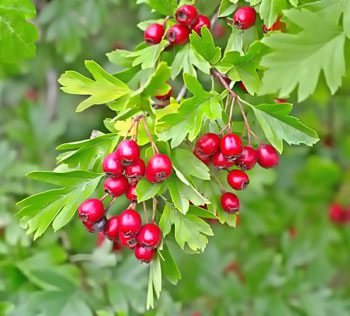In my search for western substitutions for Chinese herbs, it’s hard to ignore the easy ones. Since we’re at the end of the Spleen time of the Spleen time of year – deficient Spleen symptoms being poor digestion, difficulty losing weight, diarrhea, low appetite, fatigue, and slow metabolism – choosing hawthorn seems a perfect start to my herbal substitution blogs.
Technically, this is not really an herbal substitution but rather teaching Western herbalists to use an old favorite in a new way, although this is a type of substitute of sorts, isn’t it? The question is, can an old herb (or herbalist) learn new tricks? I hope so, because this one is really worth it!
Western hawthorn (Crataegus oxyacantha), the herb much beloved for treating heart conditions, is cherished indeed because cardiovascular diseases are the leading cause of death not only in the US but also the entire world. Hawthorn is perfect for this because it’s a cardiac tonic, regulates blood pressure, lowers cholesterol, and protects the heart all in one.
Chinese hawthorn fruits (Crataegus pinnatifida – shan zha) have another powerful use that Western hawthorn could “learn” and this one actually relates to heart problems – as a digestive aid. (I know the Chinese variety is a different species,[1] but stick with me here as all will become clear in the end.) Chinese hawthorn has long been used as a digestive to transform blockages in the stomach and intestines. In particular, it helps the body digest meat, fats, and greasy foods, alleviating symptoms of abdominal distention, pain, and watery diarrhea or dysentery (especially for the latter two when the herb is charred). It has been so widely used for this that hawthorn wafers are sold in Chinese pharmacies and markets as a tasty after-meal digestive for all ages.
And yet, the Chinese have also used their hawthorn species to circulate the blood and transform blood stasis, particularly for postpartum or lower abdominal pain and clumps, or pain in the chest. In recent years, however, the Chinese have begun to also use it for hypertension, coronary artery disease, and elevated serum cholesterol. Sound familiar?
This is why: the Chinese tested their species of hawthorn with anesthetized rabbits and found it lowered blood pressure for up to three hours. In other experiments it caused systemic vasodilation, while further experiments in China and other countries showed that various species of hawthorn grown in different parts of the world were useful in preventing and treating atherosclerosis. Lastly, other animal experiments with hawthorn showed changes in both serum cholesterol levels and coronary arteries and aorta.[2] And what underscores the similar uses of both the western and Chinese species of hawthorn? Both have the same flavors and actions – sour and sweet flavors and slightly warm energy!
What I find especially interesting about this herbal usage cross-over is that after eating a big meal or poor food combinations, many people experience pain in the chest and so fear they are having a heart attack. When they go to the hospital, one of the very first treatments for this often given in emergency rooms is a digestive such as Pepto-Bismol, which more often than not alleviates the symptoms. The doctors then know their patient’s pain was not from a heart attack but from blocked digestion. Many of us know what this feels like – just think back to the physical aftermath of a heavy meal and you’ve got the idea.
While the Chinese have researched and adopted the Western usage of hawthorn, it’s now time for Western herbalists to do the same and try hawthorn for digestion. And this is the perfect time of year to use hawthorn for digestion of meat and fats, stuffiness, abdominal distention, or pain, and watery diarrhea, or for postpartum or lower abdominal pain and clumps. Try it and watch your hawthorn horizons expand!
If you experience blurry vision, tiredness, dizziness, numbness, black spots in the visual field, dry skin, hair or eyes, and/or are easily startled or overwhelmed, then combine dang gui or gou ji berries with the hawthorn to protect your blood.
Pull out your hawthorn tincture (or wine!), take it with meals, and feel your digestion improve while your herbal skills grow!
[1] The same herb but different species may have completely different actions. For example, western black cohosh (Actaea racemosa) has a cool energy, sweet, acrid and slightly bitter flavors and enters the Liver, Spleen, Stomach and Large Intestine meridians. It has traditionally been used as an antispasmodic for rheumatic and arthritic complaints, skin rashes, and delayed and painful menstruation. Today it is used for menopausal hot flashes since it contains estrogenic substances. Chinese black cohosh (Cimicifuga heracleifolia, C. dahurica, C. foetida – sheng ma) has a cold energy with sweet and acrid flavors and enters the Lung, Spleen, Stomach, and Large Intestine channels. It is specifically used to vent measles and headaches, clear heat and toxins, treat canker sores and swollen throat, and lift the yang in prolapse.
[2] Bensky, Dan, and Gamble, Andrew, Chinese Herbal Medicine Materia Medica, (Revised Edition 1993), Eastland Press, Inc., Seattle, WA, p. 224.


So if you have low blood pressure should you avoid this?